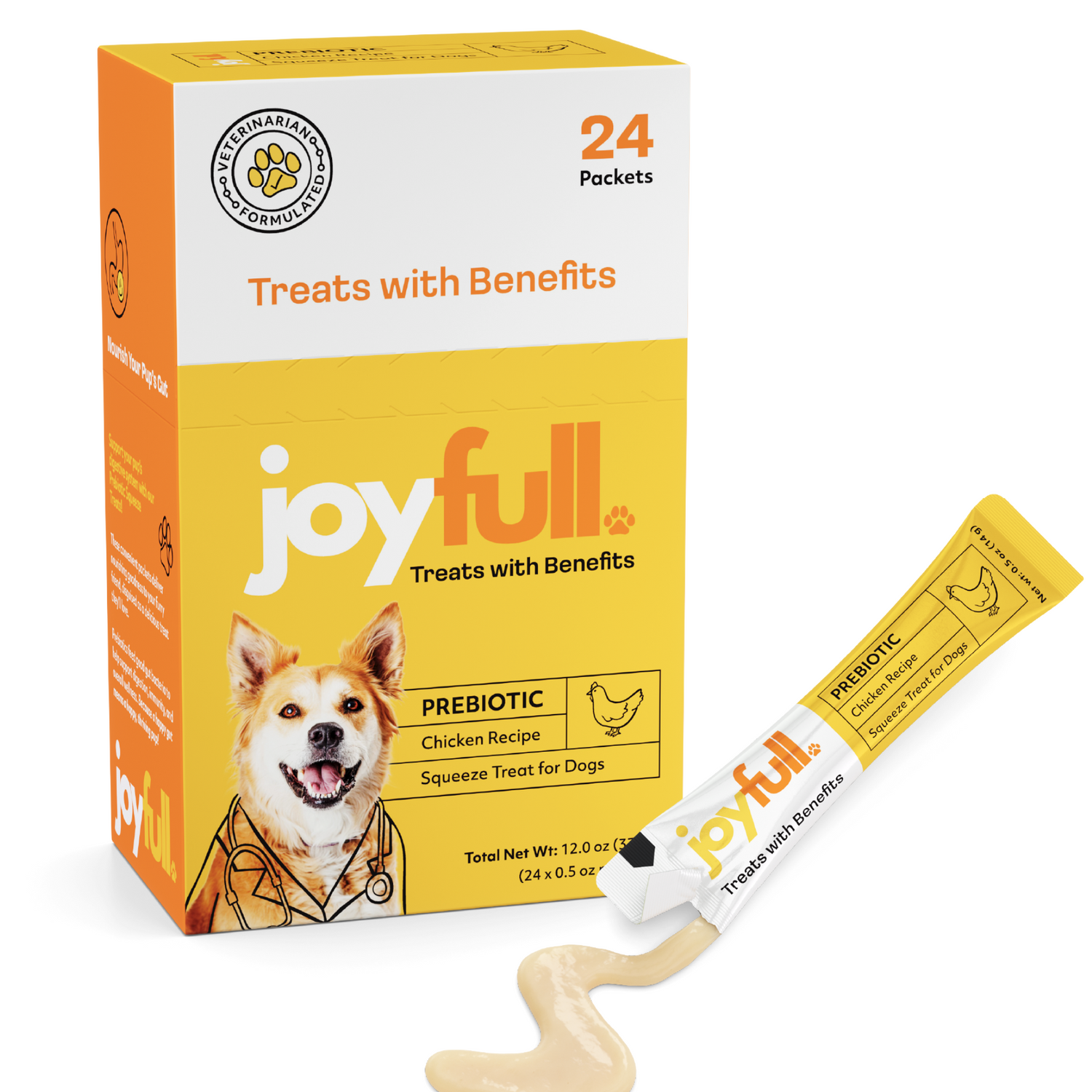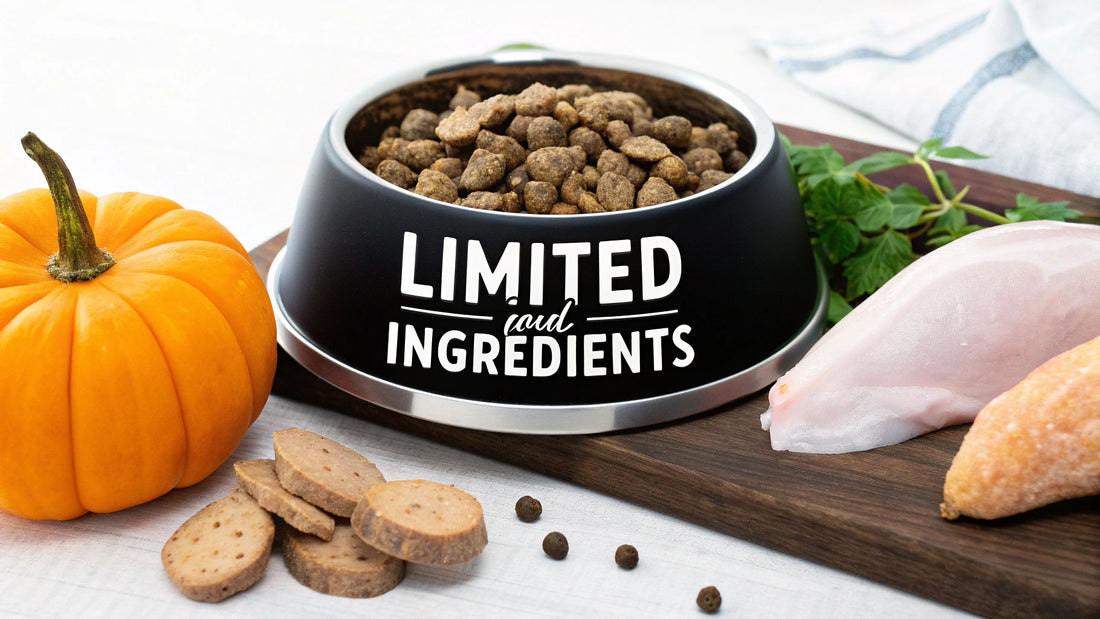
Finding the Best Limited Ingredient Dog Food
When you're on the hunt for the best limited ingredient dog food, the game plan is simple: look for a single, top-notch protein and just a handful of carbohydrates that are easy on the stomach. The best formulas often use novel proteins like duck or salmon, as these are less likely to cause a reaction in dogs who've mostly eaten chicken or beef. It's all about simplicity—the fewer things in the bowl, the easier it is to figure out what might be bothering your pup.
What Limited Ingredient Dog Food Really Means
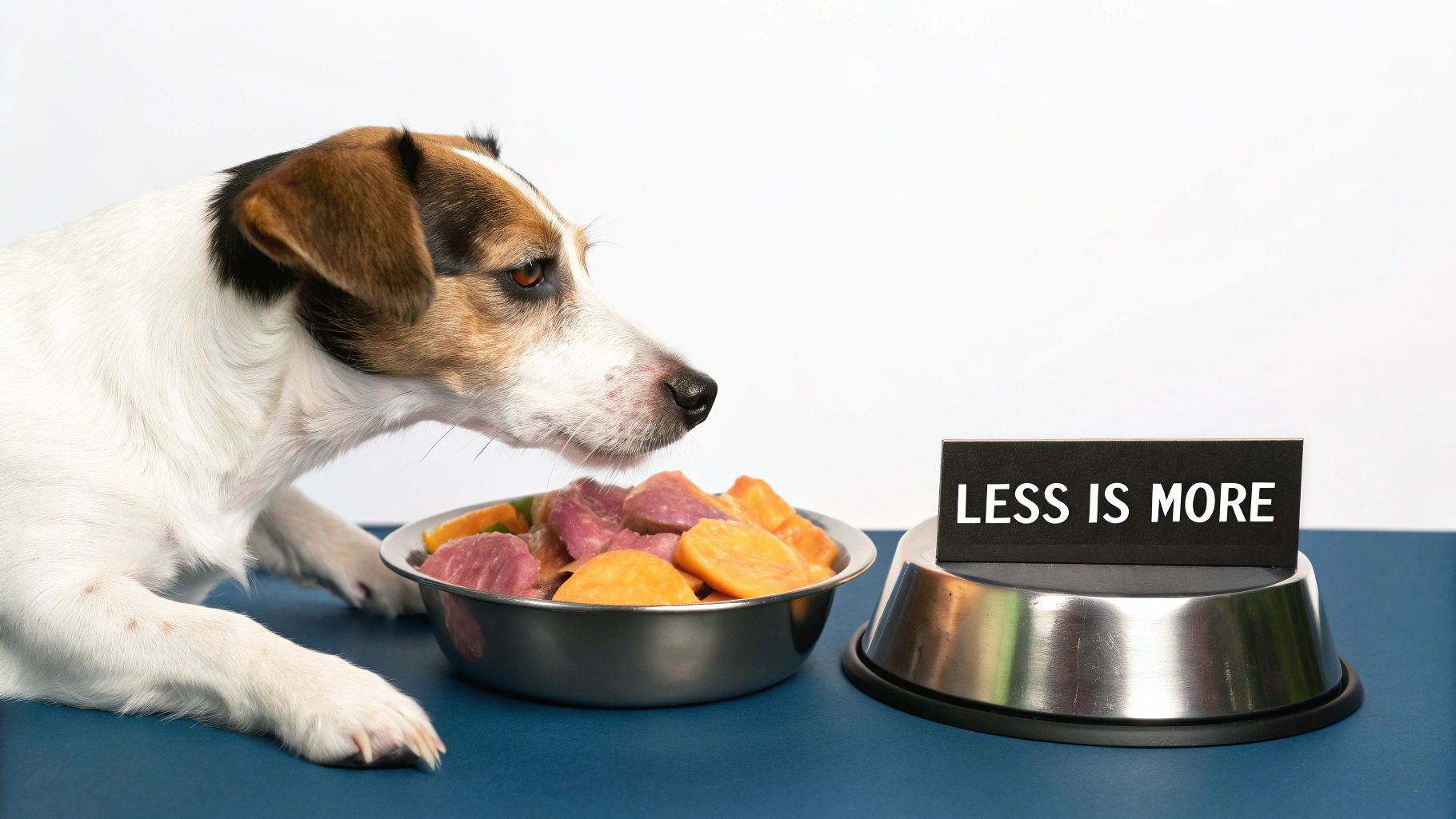
Have you ever felt like a detective trying to solve the mystery of your dog’s constant scratching or upset stomach? If so, a Limited Ingredient Diet (LID) might just be the breakthrough you need. The idea behind it is refreshingly simple: less is more. This isn't about skimping on nutrition; it’s about bringing clarity to your dog's diet.
Take a look at a typical bag of dog food. The ingredient list can read like a novel, packed with multiple proteins, a mix of grains, and a long list of synthetic extras. If your dog has a bad reaction, trying to find the culprit in a list of 30+ ingredients is a real headache.
Limited ingredient diets cut through all that noise. They’re built around one single source of animal protein (like turkey or lamb) and just one or two simple carbohydrates (like sweet potatoes or pumpkin). That’s it.
The Power of Simplicity
This minimalist philosophy changes mealtime from a potential minefield into a straightforward solution. By taking full control of what goes into your dog’s bowl, you and your vet can systematically figure out what’s causing the discomfort. It’s the exact same logic behind an elimination diet for people—remove the variables to find the problem.
This shift toward ingredient transparency is more than just a passing trend; it reflects a major change in how we think about our pets' health. The global natural pet food market, which includes these simpler formulas, is projected to climb to roughly USD 23.05 billion by 2035. This boom is driven by pet owners demanding cleaner, more understandable food for their companions. You can dig deeper into the data on the natural pet food market's growth to see what's fueling this demand.
By minimizing variables, a limited ingredient diet empowers you to understand your dog’s unique needs. It’s the first step toward managing sensitivities and improving their overall quality of life.
To really see the difference, it helps to put the two approaches side-by-side.
Standard vs Limited Ingredient Dog Food at a Glance
This quick comparison highlights the core differences between a standard kibble and a limited ingredient diet.
| Feature | Standard Dog Food | Limited Ingredient Dog Food (LID) |
|---|---|---|
| Protein Sources | Often contains multiple proteins like chicken, beef, and fish meal in one formula. | Typically features a single, novel protein source such as duck, salmon, or lamb. |
| Ingredient Count | Can have a long and complex list with 30-50+ ingredients. | Features a short, simple list, often with 10 or fewer primary ingredients. |
| Primary Goal | To provide general nutrition for the average dog without specific sensitivities. | To minimize the risk of adverse food reactions and identify potential allergens. |
| Common Carbs | May include multiple grains like corn, wheat, and soy. | Uses easily digestible carbohydrates like sweet potatoes, peas, or pumpkin. |
| Additives | Often contains artificial colors, flavors, and preservatives. | Avoids unnecessary fillers, artificial additives, and common allergens. |
As you can see, the goals are fundamentally different. One is designed for broad appeal, while the other is tailored for clarity and sensitivity management.
How to Decode a Dog Food Ingredient Label
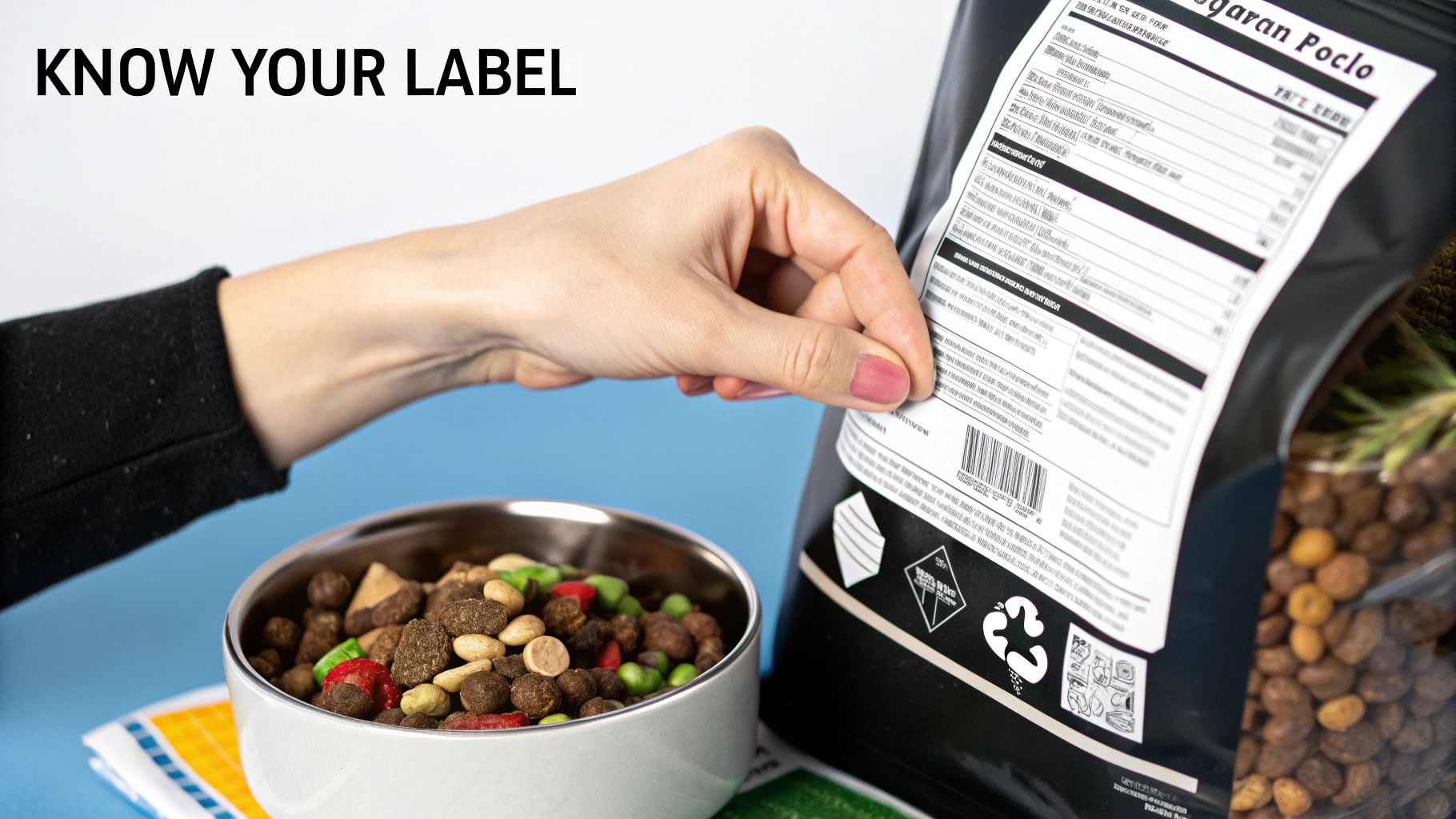
Ever feel like you need a magnifying glass and a translator to understand what’s on the back of a dog food bag? You’re definitely not alone. That wall of tiny text is where the truth about your dog's nutrition lies, and learning to read it is your best weapon in the search for the best limited ingredient dog food.
Think of the ingredient list like a recipe, with the most dominant ingredients listed first. Everything is ranked by its pre-cooking weight, so whatever you see in the first two or three spots makes up the vast majority of what’s in your dog’s bowl. That’s where you should focus your attention.
Pinpoint the Primary Protein
Your first mission is to find the main protein source. In any quality food, you want to see a single, clearly identified animal protein right at the top, like "deboned lamb" or "salmon." No mystery meats here—that kind of transparency is a great sign.
You might also see things like "duck meal" or "chicken meal." Don't let the word "meal" scare you off; it's actually a good thing. A meal is just the protein with the water and fat removed, which creates a highly concentrated protein source. So, a food listing both "duck" and "duck meal" is often packed with a solid protein punch.
This push for better, more specific proteins isn’t just a niche trend. Across the U.S. pet food market, the demand for high-value proteins has exploded. We’ve seen marine ingredients like salmon and cod increase by 95% and meat or poultry ingredients grow by 34%. It shows that pet parents everywhere are demanding cleaner, more recognizable ingredients.
Rule of Thumb: The very first ingredient on the label should always be a high-quality animal protein. If you see a grain or a vague term like "meat by-products," consider it a red flag.
Identify Fillers and Potential Allergens
Once you’ve nailed down the protein, scan the rest of the list for common fillers and potential allergens—the stuff that really has no place in a true limited ingredient diet. These are usually cheap ingredients that bulk up the food without adding much nutritional value.
Be on the lookout for these usual suspects:
- Vague Ingredients: Terms like "meat and bone meal" or "animal digest" are huge red flags. They’re intentionally ambiguous and don't tell you which animal the protein even came from.
- Common Allergens: Corn, wheat, and soy are some of the most frequent triggers for food sensitivities in dogs. It's best to steer clear of them if you're trying a simplified diet.
- Artificial Additives: Keep an eye out for artificial colors (like Red 40), fake flavors, and chemical preservatives like BHA, BHT, or ethoxyquin.
Learning to spot these key elements helps you cut through the noise and quickly judge a food’s quality. For an even deeper dive, our complete guide on how to read dog food labels has you covered. Mastering this skill lets you look right past the flashy marketing on the front of the bag and choose a food based on what really counts—the ingredients on the inside.
The Real-World Benefits of a Simplified Diet
When you switch your dog to a simplified diet, the changes you see are often tangible and happen right before your eyes. This isn't just about managing a single problem; it's about boosting their overall comfort and happiness from the inside out. The benefits are real, and they show up in everything from your dog’s coat to their zest for life.For many dog owners, the first victory is seeing relief from skin issues. That constant scratching, paw licking, and the angry, red skin that never seemed to go away can finally start to subside. Once you remove an ingredient that’s causing trouble, the body’s inflammatory response calms down, leading to healthier skin and fewer of those frustrating chronic ear infections.
A Calmer Digestive System
Beyond a shiny coat, the digestive perks of a limited ingredient diet can be game-changing. It's a bit like giving a finely tuned engine the exact fuel it needs—everything just runs smoother. When your dog's system isn't constantly battling ingredients it can't process, digestion becomes a much more peaceful, efficient process.
So, what does that look like in your day-to-day life?
- Firmer, More Consistent Stools: Say goodbye to unpredictable potty breaks. A streamlined diet helps regulate the digestive tract, making cleanup far less of a headache.
- Reduced Gas and Bloating: Less turmoil in the gut means a more comfortable dog and, let’s be honest, a much more pleasant-smelling home.
- Better Nutrient Absorption: An inflamed gut struggles to absorb nutrients. By calming it down, you ensure your dog gets all the vitamins and minerals they need to thrive.
A simplified diet doesn't just put a band-aid on symptoms; it supports the entire digestive system. Giving the gut a rest from potential irritants allows it to heal and function properly, which is the whole philosophy behind choosing the best limited ingredient dog food.
For some dogs, these diets are absolutely essential. Vets often turn to them for managing more serious gastrointestinal issues like Inflammatory Bowel Disease (IBD). A simple, clean ingredient list is key to minimizing flare-ups and providing a reliable nutritional baseline for these chronic conditions.
A Happier, More Energetic Dog
Think about it: when a dog isn't constantly dealing with itchy skin or a painful, churning stomach, their true personality can finally emerge. All that energy they were spending on being uncomfortable is now free for fetch, long walks, and cuddling on the couch. It’s incredibly common for owners to report that their dog is suddenly happier and more playful after a diet change.
A solid nutritional foundation is a cornerstone of your dog's health, complementing other veterinary care like treating eye conditions in dogs. At the end of the day, a simplified diet is about so much more than what's in the bowl. It’s about giving your dog their comfort, their joy, and their quality of life back. The link between a focused diet and a thriving dog is undeniable.
Choosing the Right Limited Ingredient Dog Food
Okay, now it's time to put all this knowledge to work and find the perfect food for your dog. You’ve learned how to read the labels and understand the benefits, so you're ready to pick the best limited ingredient dog food that fits your pup's specific needs. Think of it less like shopping and more like being a personal chef for your dog.
Your main goal is to build a simple, clean meal plan with ingredients that nourish your dog without causing a reaction. The first and most important piece of this puzzle is the protein.
Select a Truly Novel Protein
The term “novel protein” sounds fancy, but it just means a protein source your dog has rarely, or never, eaten before. Most food sensitivities and allergies pop up after a dog has been eating the same common proteins—like chicken or beef—for years. By switching to something new, you can often sidestep the problem entirely.
It's a simple but effective strategy. If your dog has been on chicken kibble his whole life and is now itchy and miserable, moving to a food where rabbit or venison is the star protein can make a world of difference. You're essentially giving their immune system a fresh start, avoiding the triggers it has learned to react to.
Just look at how the numbers stack up when comparing common allergens.
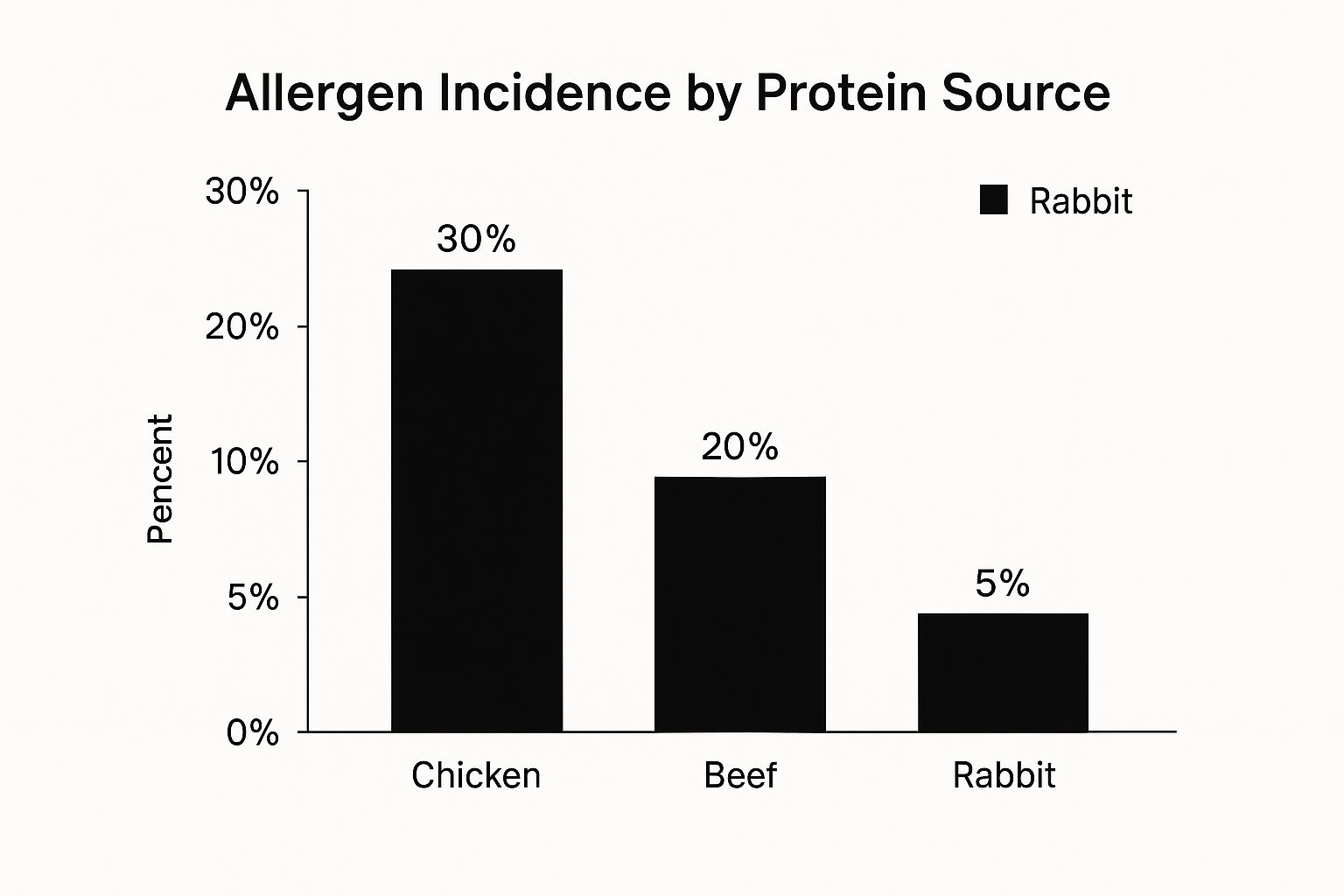
The data makes it pretty clear: proteins like rabbit are far less likely to cause an issue than the old standbys like chicken and beef.
Choose Gentle Carbohydrates
Once you've picked your protein, the next step is to pair it with a carbohydrate that's easy on the digestive system. Again, the goal is to avoid common troublemakers. A lot of dog foods use corn, wheat, or soy, which are well-known irritants for sensitive dogs.
Instead, you want a formula built around simple, whole-food carbs that provide energy and fiber without causing chaos in the gut.
Some of the best options include:
- Sweet Potatoes: They’re packed with vitamins and fiber and are famously gentle on the stomach.
- Pumpkin: A go-to for digestive health, pumpkin is great for firming up stool and soothing an upset tummy.
- Peas or Lentils: These add both carbs and some plant-based protein, but just make sure your dog tolerates them well.
When you combine a single novel protein with a single, simple carbohydrate, you’re creating an incredibly clean diet. This makes it so much easier to see what’s working and what isn’t. To learn more about what not to include, take a look at our guide to finding dog food without fillers.
Deciding between all the novel proteins and gentle carbs can feel overwhelming. To make it easier, here's a quick comparison of some popular choices you'll find in limited ingredient diets.
Comparing Common Limited Ingredient Protein and Carb Sources
| Source Type | Common Examples | Best For Dogs With Sensitivities To... | Key Benefit |
|---|---|---|---|
| Novel Proteins | Rabbit, Venison, Duck, Lamb | Chicken, Beef, Fish | Low allergenicity; provides a "clean slate" for the immune system. |
| Gentle Carbs | Sweet Potato, Pumpkin | Grains (Wheat, Corn, Soy) | Highly digestible and rich in essential vitamins and fiber. |
| Legumes | Peas, Lentils, Chickpeas | Grains, Potato | Grain-free energy source that also adds plant-based protein. |
This table can act as your cheat sheet for matching ingredients to your dog's specific dietary history and needs.
Final Checks Before You Buy
Before you head to the checkout, there are two last things you absolutely must do.
First, flip the bag over and find the AAFCO nutritional adequacy statement. This is your proof that the food is a complete and balanced meal for your dog's life stage, whether they're a puppy, an adult, or a senior. Don't skip this.
Second—and this is the big one—talk to your veterinarian. Your vet knows your dog's health history and can help you make an informed choice, or even rule out other medical issues that might be causing the symptoms. Their expertise is your best resource for getting this right.
How to Transition Your Dog to a New Food
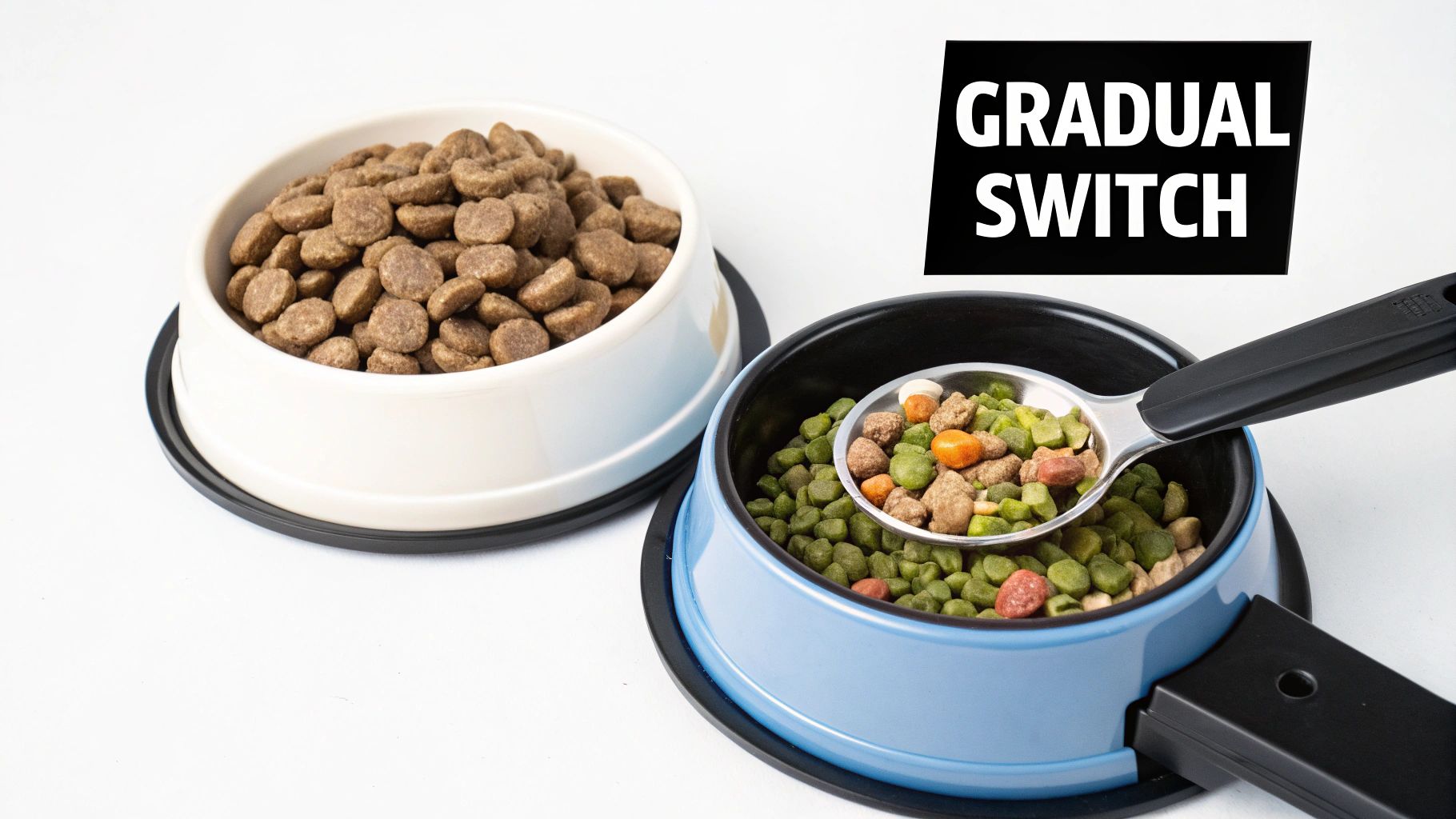
So, you've done the research and picked out the best limited ingredient dog food for your buddy. Great! But hold on—the final step is just as important as the first. You can't just swap out their old food for the new one overnight.
A dog's digestive system loves routine. A sudden change in diet can easily trigger stomach upset, diarrhea, or vomiting, which is exactly what we're trying to avoid. The key to a happy gut is a slow, gradual transition. It gives their system time to get acquainted with the new ingredients.
The Foolproof 7-Day Transition Plan
Patience is your best friend here. By slowly mixing the new food with the old, you give your dog’s gut bacteria a chance to adapt. Rushing this can undo all your hard work.
This simple schedule is our go-to method for a seamless switch. For an even deeper dive, you can read our complete guide on how to transition a dog to new food.
Here’s the day-by-day breakdown:
- Days 1-2: Start with a mix of 25% new food and 75% old food.
- Days 3-4: Go half-and-half. That's 50% new food mixed with 50% old food.
- Days 5-6: Tip the scales to 75% new food and just 25% old food.
- Day 7: You've made it! Serve 100% new food.
If you know your dog has an extra-sensitive stomach, don't be afraid to stretch this out over 10 or even 14 days. Just make the changes in smaller increments.
The goal is to make the change so gradual that your dog’s digestive system barely notices anything is different until the transition is complete. This minimizes stress and maximizes success.
Throughout this week (or two), keep a close watch on your dog. Check their stool quality to make sure it stays firm. Keep an eye on their energy levels and appetite, too. A happy dog who cleans their bowl is the best sign that the new food is a hit.
If you see any ongoing digestive issues, simply slow down the process. And of course, if you're ever concerned, a quick call to your vet is always a good idea.
Got Questions About Limited Ingredient Diets? We’ve Got Answers.
Diving into the world of limited ingredient diets can feel a little overwhelming, and it's natural to have questions. It’s a big decision to change what goes into your dog’s bowl, so you want to get it right. Let's walk through some of the most common things pet parents wonder about, so you can feel confident in your next steps.
How Long Should My Dog Stay on a Limited Ingredient Diet?
This is a great question, and the answer really comes down to your primary goal. Are you investigating a problem, or are you managing a known sensitivity?
For many, these diets are a short-term tool. If your vet suspects a food allergy, they'll likely start an elimination trial. This means feeding only the new, simplified diet for a solid 8 to 12 weeks. That gives the body enough time for any inflammation to calm down, which can tell you if a specific food ingredient was the real troublemaker.
But what if you already know chicken makes your dog miserable and they’re doing fantastic on a new food? In that case, it can absolutely be their meal for life. The only catch is making sure the formula is "complete and balanced" for their age and lifestyle.
What if My Dog Isn’t Getting Better on the New Food?
It’s incredibly frustrating to make a thoughtful switch and see no change. If you're a few weeks in and your dog's symptoms are still hanging around, it’s time to put your detective hat back on and consider what else could be going on.
A few possibilities come to mind:
- You haven't found the right formula yet. Your dog could be sensitive to an ingredient still present in the new food—even a "novel" protein or a common plant ingredient like peas.
- The problem isn't their food. It’s easy to blame the food bowl, but so many things can cause itchy skin or an upset stomach. Environmental allergies from things like pollen, dust mites, or grass look almost identical to food allergies.
- There’s an underlying health issue. Sometimes, persistent skin or gut problems are a symptom of something else entirely.
This is where your vet becomes your most important partner. They can help you rule out other causes and figure out the best path forward for your dog.
Are These Diets Safe for Puppies or Senior Dogs?
Absolutely, as long as you choose the right one. Limited ingredient diets can be a fantastic option for dogs at any stage of life, but you have to pick a formula specifically designed for their age. This is one area where "one-size-fits-all" just doesn't cut it.
A growing puppy has completely different nutritional demands than an aging senior. It is non-negotiable for their long-term health to choose a food that is either labeled "for all life stages" or, even better, is made specifically for puppies or seniors.
Puppies need more calories, protein, and crucial minerals like calcium to build strong bones and muscles. A senior dog, on the other hand, might need fewer calories to stay trim, along with added nutrients like glucosamine to support their joints. Always double-check the AAFCO statement on the packaging to be sure.
Here at JoyFull, we believe a simpler diet is often a smarter diet. Our recipes are built around clean, high-quality proteins without the unnecessary extras, giving your dog the targeted nutrition they need to feel their best. Explore JoyFull’s limited ingredient options today!
